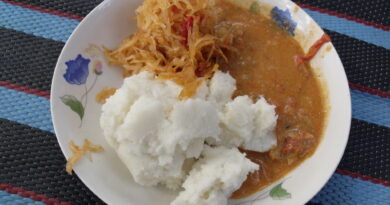Afang
Exploring Afang: A Culinary Journey Through Nigeria’s Delightful Green Soup
Introduction
Nigerian cuisine is a vibrant tapestry of flavors and textures, reflecting the rich cultural diversity of the country. Among the myriad of delicious dishes, Afang soup stands out as a culinary gem that embodies the essence of Nigerian cooking. This traditional soup, originating from the Efik people in the southeastern part of Nigeria, has gained widespread popularity for its unique combination of ingredients and its ability to tantalize the taste buds. Join us on a culinary journey as we delve into the history, ingredients, preparation, and cultural significance of Afang soup.
The Roots of Afang Soup
To truly appreciate Afang soup, it’s essential to understand its historical roots and cultural significance. The soup traces its origins to the Efik people, one of Nigeria’s major ethnic groups, primarily residing in Cross River State. Efik cuisine is known for its use of fresh, locally sourced ingredients, and Afang soup is a perfect example of this culinary philosophy.
The name “Afang” is derived from the wild vegetable used as a primary ingredient in the soup. The Gnetum africanum, also known as afang leaf or ukazi in some regions, is a dark green leafy vegetable with a unique flavor profile. It contributes a distinctive taste and texture to the soup, making it a key element in the dish.
Ingredients that Define Afang Soup
Afang soup is a delightful blend of various ingredients that come together to create a harmonious and flavorful dish. While recipes may vary slightly across regions and households, certain core components define the essence of this soup:
- Afang Leaves (Ukazi): As mentioned earlier, the afang leaves are the star of the show. These dark green, glossy leaves contribute a slightly bitter taste and a chewy texture to the soup.
- Waterleaf: Another crucial leafy green in Afang soup is waterleaf. This vegetable adds a mild, slightly tangy flavor to the dish and contributes to the overall balance of textures.
- Protein: Afang soup traditionally features a combination of protein sources, including assorted meats such as goat meat, beef, or cow tripe (shaki). Fish, particularly catfish or tilapia, is also a popular addition.
- Stockfish and Periwinkle: To enhance the soup’s depth of flavor, stockfish and periwinkle are often included. Stockfish, dried and smoked fish, adds a smoky richness, while periwinkle imparts a unique seafood taste.
- Palm Oil: A staple in Nigerian cooking, palm oil is used to add a rich, red hue to the soup and infuse it with a distinctive, earthy flavor.
- Seasonings and Spices: A blend of spices, including onions, garlic, ground pepper, and crayfish, contributes to the complexity of Afang soup’s flavor profile.
Preparing Afang Soup: A Labor of Love
The preparation of Afang soup is a culinary art that requires time, patience, and attention to detail. Each step is crucial in ensuring the final dish’s depth of flavor and authenticity. Here’s a simplified version of the cooking process:
- Prepare the Ingredients: Clean and chop the afang leaves, waterleaf, and other vegetables. Cut the meat and fish into bite-sized pieces.
- Boil the Protein: In a large pot, combine the assorted meats with stockfish and periwinkle. Season with salt, onions, and other desired spices. Allow the mixture to boil until the meats are tender.
- Add Palm Oil: In a separate pot, heat palm oil until it becomes clear. Be cautious not to overheat and burn the oil. Add chopped onions and let them sauté until they become translucent.
- Create the Base: Transfer the boiled meat and stockfish into the pot with the palm oil and onions. Stir well to combine, creating a flavorful base for the soup.
- Add Vegetables: Gradually add the chopped afang leaves and waterleaf to the pot. Stir gently to avoid breaking the leaves. Allow the vegetables to cook until they are tender.
- Season to Taste: Season the soup with ground pepper, crayfish, and additional salt as needed. Stir well to ensure the spices are evenly distributed.
- Simmer to Perfection: Let the soup simmer over low heat, allowing the flavors to meld together. This slow-cooking process is crucial for achieving the rich and savory taste that characterizes Afang soup.
Cultural Significance of Afang Soup
Beyond its delectable taste, Afang soup holds cultural significance in Nigerian society. It is often associated with special occasions, celebrations, and communal gatherings. The act of preparing and sharing Afang soup is a way of fostering unity and strengthening social bonds.
In many Nigerian households, the preparation of Afang soup is a communal effort, bringing family members together to participate in the cooking process. The dish is often served at weddings, festivals, and other joyous occasions, symbolizing abundance, prosperity, and togetherness.
Afang Soup Across Nigeria: Regional Variations
While the basic components of Afang soup remain consistent, there are regional variations that add a unique touch to the dish. Different ethnic groups and communities may incorporate local ingredients or tweak the preparation method to suit their tastes. Let’s explore a few regional variations of Afang soup:
- Efik and Ibibio Versions: In the Efik and Ibibio communities, where Afang soup originated, the dish is often prepared with a higher proportion of waterleaf. The result is a soup with a lighter, more refreshing taste.
- Igbo Variation: In Igbo-speaking regions, the addition of achara (Ogiri Igbo), a traditional fermented condiment, is not uncommon. This imparts a distinct umami flavor to the soup, enhancing its overall complexity.
- Yoruba Twist: In Yoruba-speaking regions, the inclusion of locust beans (iru) is a popular variation. Locust beans contribute a unique flavor and aroma, adding depth to the soup.
- Northern Adaptations: In the northern parts of Nigeria, where ingredients like waterleaf may be less readily available, cooks may substitute it with spinach or other locally abundant greens. This adaptability showcases the versatility of Afang soup.
Health Benefits of Afang Soup
Beyond its delicious taste and cultural significance, Afang soup also offers several health benefits. The inclusion of nutrient-rich vegetables, lean meats, and fish makes it a nutritious choice. Here are some of the health benefits associated with Afang soup:
- Rich in Vitamins and Minerals: Afang leaves and waterleaf are excellent sources of vitamins A and C, as well as essential minerals like iron and calcium. These nutrients contribute to overall health and well-being.
- Protein-Packed: The combination of meats and fish in Afang soup provides a significant protein boost. Protein is essential for muscle development, immune function, and overall growth.
- Heart-Healthy Fats: While palm oil is high in saturated fats, it also contains heart-healthy monounsaturated fats. When consumed in moderation, palm oil can contribute to a well-balanced diet.
- Low in Carbohydrates: Afang soup is relatively low in carbohydrates, making it a suitable option for those following low-carb or ketogenic diets.
Conclusion
In conclusion, Afang soup is a culinary masterpiece that transcends its role as a delicious dish. Rooted in Nigerian culture and cherished for its unique blend of flavors, this traditional soup has found its way into the hearts and homes of people across the country. From the lush landscapes of the southeastern region to the bustling cities of the north and west, Afang soup continues to be a symbol of unity, celebration, and the rich tapestry of Nigerian cuisine.
Whether you’re savoring it at a festive gathering, enjoying a bowl with family, or experimenting with regional variations in your kitchen, Afang soup invites you to embark on a sensory journey that celebrates the diversity and warmth of Nigerian culture. So, the next time you’re in the mood for a hearty and flavorful dish, consider preparing or indulging in a bowl of Afang soup – a true embodiment of Nigeria’s culinary heritage.



